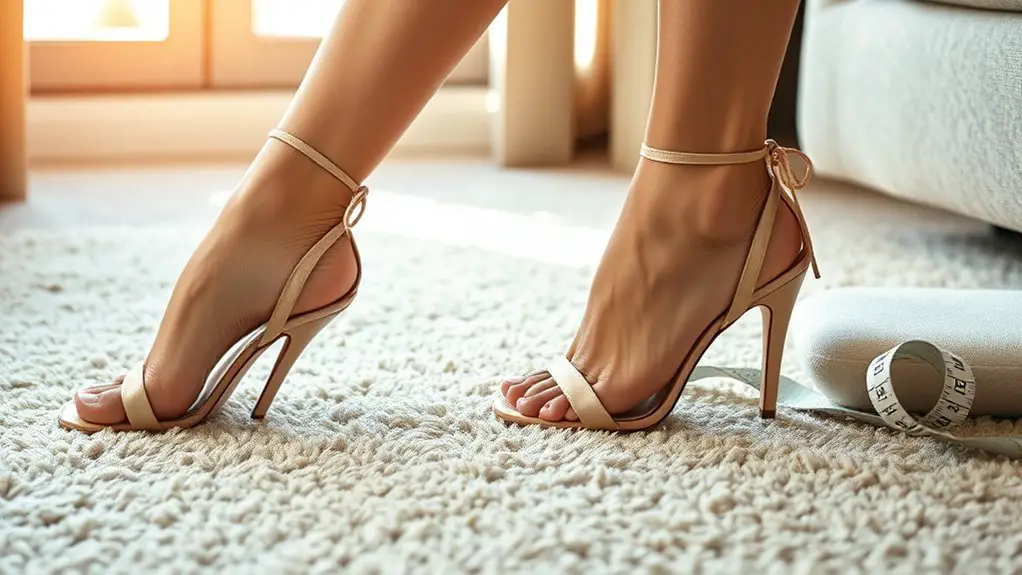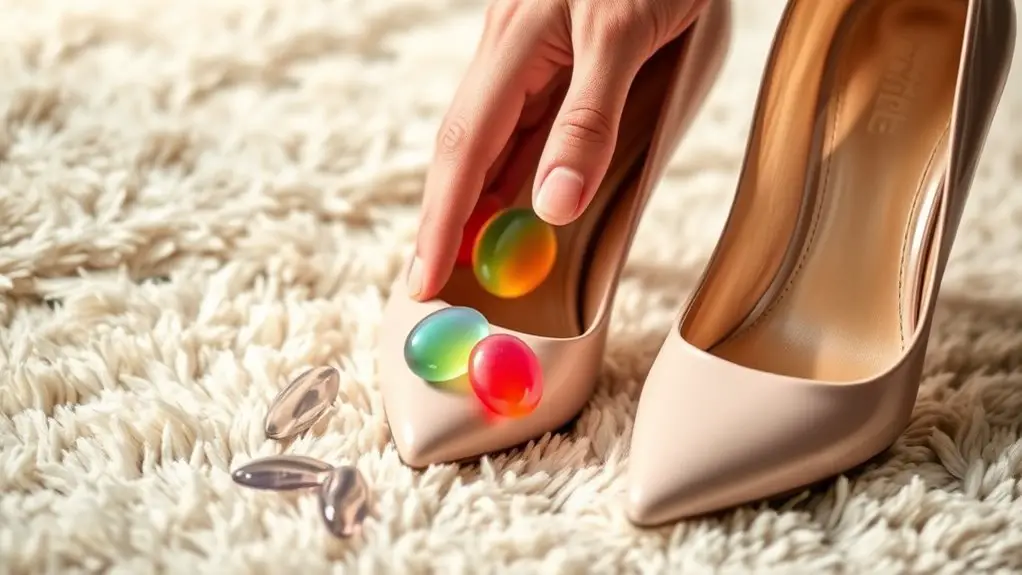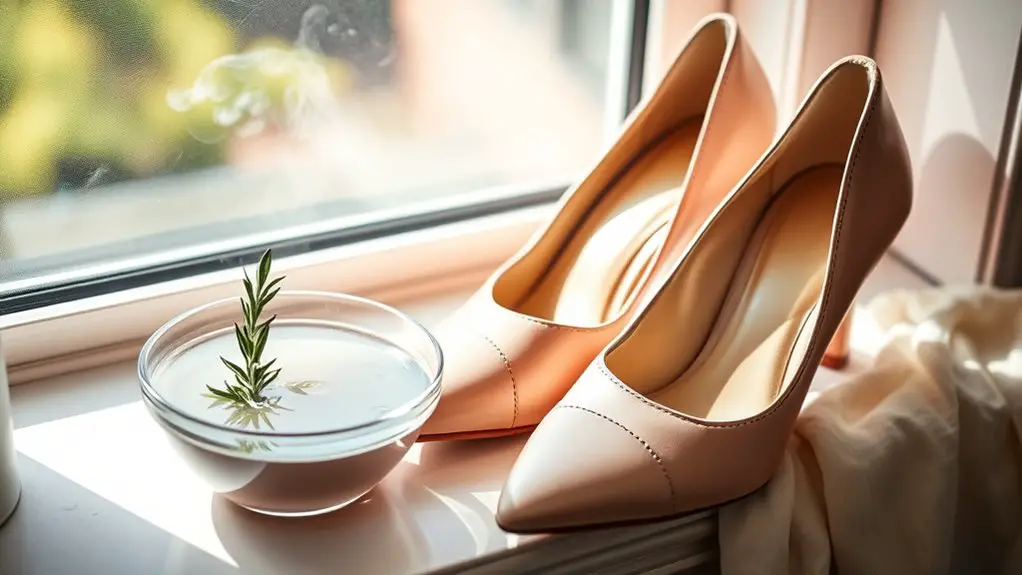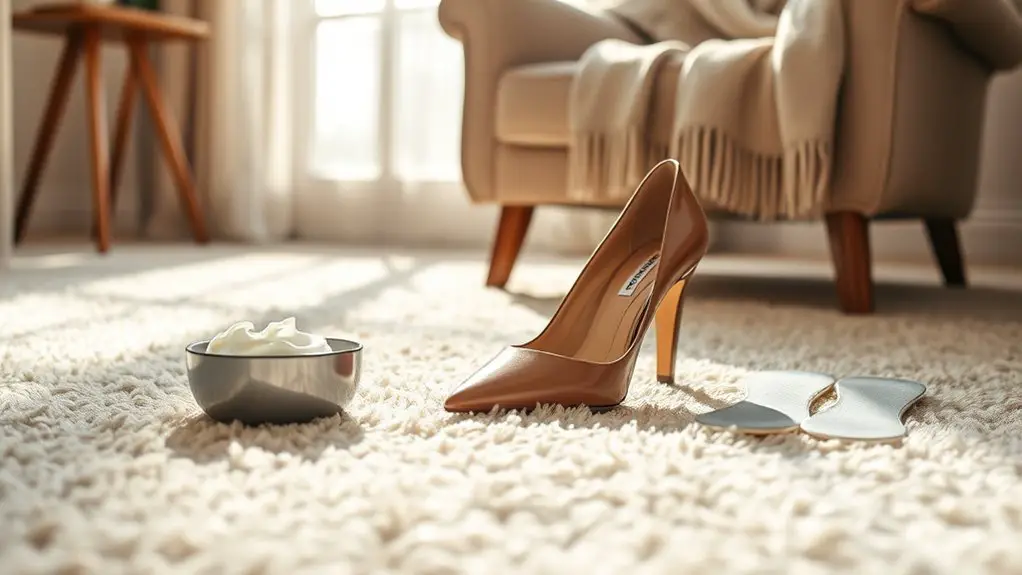To break in new heels without pain, start by ensuring you’ve got the right size and fit. Choose styles that support your arch and consider your foot shape. Gradually wear your heels for short periods to help your feet adjust. Use protective cushions and inserts for added comfort, and try stretching the material at home if needed. Also, consider moisture and heat to ease the process. There are more tips and tricks that can help you achieve a pain-free experience.
Choose the Right Size and Fit

Choosing the right size and fit for your new heels is vital to guaranteeing comfort and avoiding blisters. When considering heel sizing, it’s important to know your exact shoe size, as sizing can vary between brands. Don’t just rely on the number; pay attention to how the shoes feel. Your foot shape plays a significant role in this process. If you have wider or narrower feet, make certain to choose heels that accommodate those dimensions. Look for styles that provide adequate arch support and cushioning, as these features can alleviate pressure points. Always try on heels with the type of socks or tights you plan to wear, as this can affect the fit. Remember, a snug fit is important, but it shouldn’t be painfully tight. Prioritize comfort to guarantee you can enjoy your new heels without the risk of blisters or discomfort.
Gradual Wear: Start Slow
When breaking in new heels, it’s essential to start with short outings to allow your feet to adjust. Aim for brief periods of wear and gradually increase the time as your comfort level improves. This approach helps prevent discomfort and guarantees a smoother adjustment to longer wear.
Short Outings First
To avoid overwhelming your feet, it’s best to start with short outings when breaking in new heels. These initial experiences help your feet adjust gradually without excessive strain. Aim for outings that last 30 minutes to an hour, allowing your body to adapt to the new height and support.
Here’s a simple table to track your short outings:
| Outing Duration | Activity |
|---|---|
| 30 minutes | Coffee date |
| 45 minutes | Grocery shopping |
| 1 hour | Casual lunch |
| 30 minutes | Walk in the park |
| 1 hour | Evening event |
Increase Wear Time Gradually
After you’ve successfully completed several short outings, it’s time to gradually increase the wear time of your new heels. Start by adding an extra hour to your heel-wearing schedule each time you step out. This gradual approach helps your foot anatomy adjust to the specific heel materials, reducing discomfort. Pay attention to how your feet feel; if you notice any soreness, it might be wise to dial back the time. Incorporating supportive insoles can also be beneficial during this phase, as they provide extra cushioning and support. Remember, everyone’s feet respond differently, so listen to your body. The goal is to build endurance without forcing your feet into prolonged discomfort. With patience, you’ll be strutting confidently in your heels!
Use Protective Cushions and Inserts

While breaking in new heels can be a challenge, using protective cushions and inserts can greatly enhance your comfort. These additions can relieve pressure on your feet and prevent blisters. It’s crucial to choose the right cushion types and insert materials for your needs.
Here’s a handy comparison to help you decide:
| Cushion Type | Insert Material | Benefits |
|---|---|---|
| Gel cushions | Silicone | Shock absorption |
| Foam pads | Memory foam | Custom fit and support |
| Arch supports | Hard plastic | Stability and alignment |
Stretch Your Heels at Home
Using protective cushions and inserts can make a significant difference in your comfort, but sometimes your new heels need a bit of extra help to fit just right. One effective way is through shoe stretching using DIY methods. Start by wearing thick socks and then slipping on your heels. Walk around your home for about 30 minutes; the warmth from your feet will help stretch the material.
Alternatively, you can fill a spray bottle with water and lightly mist the interior of the shoe, then wear them with thick socks. Another method involves using a shoe stretcher, which can expand the shoe gradually. If you don’t have one, consider placing a bag of water inside the shoe and freezing it overnight. As the water freezes, it’ll expand and stretch your heels. These techniques can enhance comfort and make your new heels more wearable without the pain.
Consider Moisture and Heat

Moisture and heat can be your best allies when breaking in new heels. To start, consider using moisture control methods like wearing thick socks when trying on your new shoes. This helps to create a snug fit while allowing the materials to soften. If your heels are particularly stiff, a bit of heat application can make a significant difference. You can use a hairdryer on a low setting to gently warm the areas that feel tight. Just be careful not to overheat, as this can damage the shoe.
After applying heat, walk around for a few minutes to let your feet mold the shoes. This combination of moisture and warmth not only eases the breaking-in process but also enhances comfort. Remember, patience is key—don’t rush the process, and soon your new heels will feel like a second skin.
Alternate With Comfortable Footwear
After you’ve taken steps to soften your new heels with moisture and heat, it’s important to give your feet a break. Alternating with comfortable footwear can greatly ease the breaking-in process. Consider incorporating stylish flats or even chic sneaker options into your wardrobe. Not only do these choices provide relief, but they also keep your look fashionable.
When you’re not showcasing your new heels, slip into a pair of supportive sneakers or flats that offer cushioning and flexibility. This not only allows your feet to recover but also helps you avoid blisters and discomfort. You can even choose versatile styles that can shift from day to night, giving you both comfort and style.
Frequently Asked Questions
Can I Wear New Heels for an Entire Day Immediately?
You shouldn’t wear new heels all day right away. It’s fashion advice to gradually break them in. Consider heel alternatives, like stylish flats, for the first day to guarantee comfort while you adjust.
How Long Does It Typically Take to Break in New Heels?
Typically, breaking in new heels takes a few days to a week. Using various breaking in techniques, like wearing them for short periods and ensuring a proper heel fitting, can help ease discomfort and speed up the process.
Are Certain Heel Types Easier to Break in Than Others?
Certain heel types indeed vary in break-in ease. Block heels offer stability and comfort, making them easier to adjust to. In contrast, stilettos present challenges due to their height and narrow structure, requiring more time to adapt.
What Materials Are Best for Comfortable Heels?
Imagine walking on clouds; that’s what the right materials can feel like. Leather’s breathability complements cushioned insoles, while synthetic options offer flexibility. Choosing wisely guarantees comfort, letting you conquer any runway without a care.
Should I Avoid Heels Altogether if I Have Foot Issues?
If you have foot issues, you should consider avoiding heels altogether. Instead, explore heel alternatives that prioritize foot health. Your comfort and well-being should always come first when choosing footwear that supports your feet effectively.



